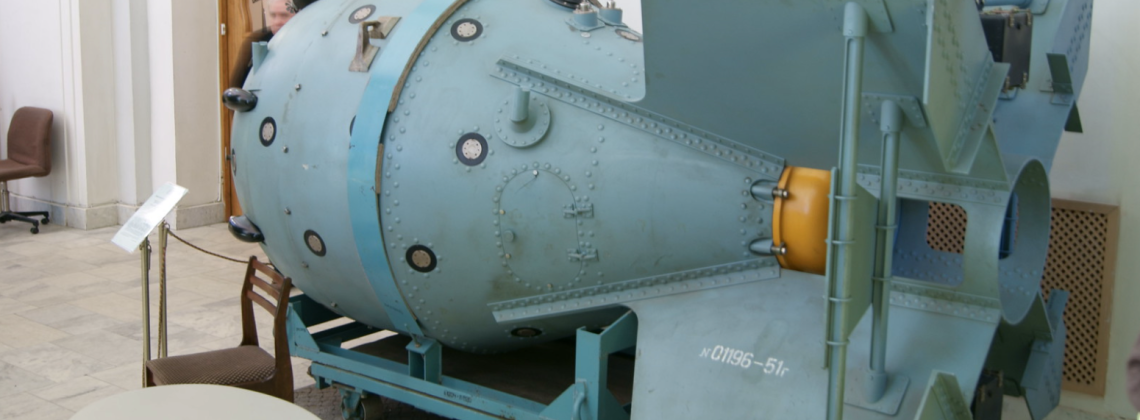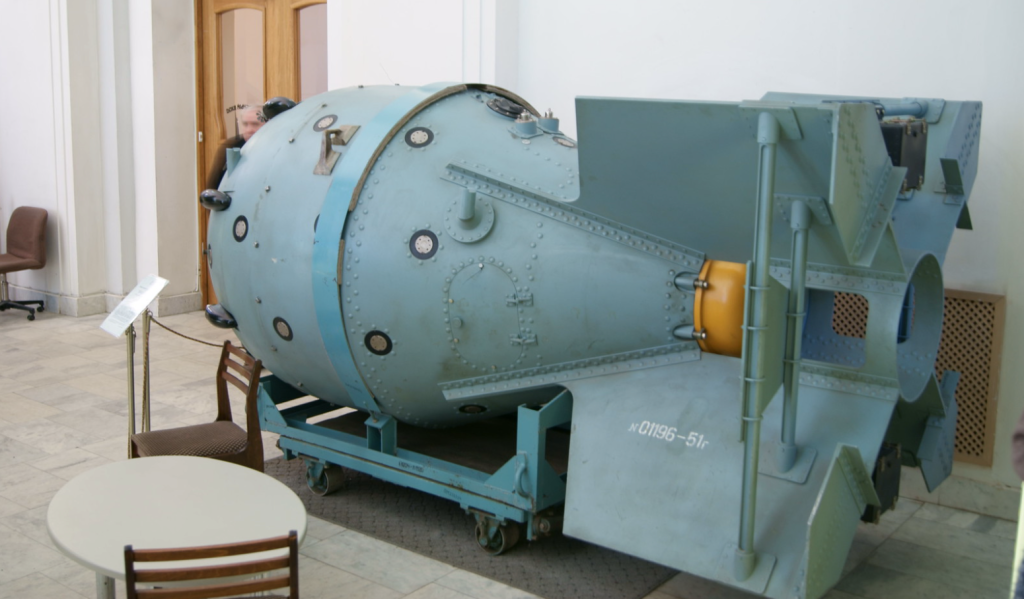

The deceptions that followed Ukraine’s nuclear disarmament have raised the level of threat
Inheriting the Bomb: The Collapse of the USSR and the Nuclear Disarmament of Ukraine by Mariana Budjeryn. Johns Hopkins University Press, 2022. 328 pp., $34.95
The dropping of the atomic bomb on Hiroshima on August 7, 1945 was one of the most profound developments in military history, and perhaps all of human history. The bomb caused enormous human suffering, even as it helped end years of suffering.
But this first use of a nuclear weapon set in motion further developments that profoundly elevated future stakes in war. Quick to grasp the implications of Hiroshima was Yale Professor Bernard Brodie. On a quiet morning in New Haven, Connecticut, in the aftermath of Hiroshima’s destruction, Brodie determined that he must discard his life’s work on naval theory to become a nuclear theorist.
For Brodie, the nuclear bomb changed everything. Brodie conjectured that militaries previously existed to “win wars.” Now, however, militaries must strive above all else to “avert” them. A generation of U.S. military officers that had just unleashed total war upon Japan and Germany took longer than Brodie did to adjust to this dramatic change in warfare. While civilian leaders and Western society at large quickly came to view these new weapons as unusable, military officers viewed the first generation of atomic weapons as nothing more than larger conventional bombs. Stanley Kubrick masterfully captured this divide in his 1958 black comedy Dr. Strangelove, released thirteen years after Hiroshima.
In between the dropping of “Little Bomb” and the releasing of Dr. Strangelove, scientists had devised an even more revolutionary nuclear weapon: the hydrogen bomb. Whereas the fission bombs dropped on Japan ranged from fifteen to twenty kilotons, the first test of a hydrogen fusion bomb by the U.S. in 1952 resulted in a 10,000 kiloton explosion. This test dwarfed the yield of another bomb, Little Boy, a mere .0015 percent the size of the new fusion bomb. Nine years later, the Soviets tested their infamous Tsar Bomba, which contained an even more staggering fifty-seven megatons of explosive capability.
The almost unimaginable capability of thermonuclear weapons to kill an entire nation resulted in the rise of the policy of mutually assured destruction. Both the Soviet Union and the U.S. assumed that as long as each nation could assure its own second-strike capability in response to a first strike neither nation would precipitate a nuclear war. After all, the cost of a first strike paired with a second strike assured devastation. Given the infinite cost of nuclear war, both nations had effectively deterred themselves.
As a result, most observers until recently accepted the belief that nuclear war is unthinkable. Since 1999, however, the potential for nuclear war has begun to increase. Having watched the exquisite conventional precision capabilities of U.S. airpower not only against Iraq in 1991 but also against Serbia in 1999, Russia began considering using tactical nuclear weapons as a feasible counter. By showing a willingness to “escalate to deescalate,” Russia hoped to convince its opponents that the only feasible solution to the given conflict would be to accede to Russian demands.
Then Russia invaded Ukraine in the spring of 2022 and increasingly stepped up its rhetoric regarding nuclear weapons. Meanwhile, many pundits suggested that if only Ukraine had retained its nuclear weapons after the fall of the Soviet Union, Russia might have been deterred from its blatant conventional invasion.
In light of the invasion, it is indeed hard to imagine how Ukraine could have ever been persuaded to give up its nuclear weapons. But that perspective comes from the benefit of hindsight. In Inheriting the Bomb: The Collapse of the USSR and the Nuclear Disarmament of Ukraine, Mariana Budjeryn argues that Ukraine’s decision to give up its weapons was the right solution not only for the world but also for Ukraine. Drawing on diplomatic and military history after the Soviet Union’s collapse and the challenges of keeping nuclear weapons operational, Budjeryn reveals the complexities of negotiating Ukraine’s nuclear disarmament.
Budjeryn works for the Project on Managing the Atom at the Harvard Kennedy School’s Belfer Center. She has traditional academic credentials, including a Ph.D. in Political Science from Central European University (formerly) in Budapest, Hungary, a university itself birthed in the collapse of the Soviet Union.
From the start, Budjeryn acknowledges that Russia’s invasion of Ukraine has only made her “job of persuading Ukrainians, and those in a similar security predicament, that the answer is not nuclear weapons” incredibly more challenging than it already was. In doing so, she has forthrightly put her cards on the table. In this and in other ways, Budjeryn refuses to write the traditional academic tome, and this makes her work refreshing.
In her acknowledgments, for example, she thanks the multiple academic presses who eschewed her manuscript, in order to single out her eventual publisher Johns Hopkins Press for what she thinks ended up being the best choice. Similarly, her prologue is highly personal. She recalls her experience on a “beautiful, crisp spring day” just before the Chernobyl nuclear power plant exploded as well as the trauma multiple generations of her family experienced in the former Soviet Union. That experience, seared into the author’s memory, makes her exceedingly wary of nuclear weapon proliferation.
Moving quickly past the shaping of her own worldview, Budjeryn transitions into the Soviet Union’s collapse, which precipitated a crisis for the international community. Ukraine suddenly found itself in possession of the world’s third-largest nuclear arsenal, including almost two thousand intercontinental ballistic missiles (ICBMS) designed to strike the United States.
Budjeryn provides the reader with the necessary background to understand the collapse of the Soviet Union and the kind of debates that emerged in the aftermath of that collapse. The author’s discussion of the interplay between Ukraine, Russia, the United States, the European Union, and other actors reveals more than just a tug of war over nuclear weapons.
Indeed, the book examines “how power and the international normative environment interact and reinforce each other,” since nation states are “woven into the fabric of the international system by a web of institutions, relationships, practices, norms, and shared understandings.” As a result, there was no single easy answer to the challenge of Ukrainian nuclear disarmament. The collapse of the Soviet Union further challenged the international situation because the former Soviet states were not proliferating nuclear weapons; they had simply inherited them.
The author walks the reader through the challenging negotiations between political and military leaders as well as between the emerging nations themselves. These actions resulted in the Lisbon Protocol that provided important carrots to the former Soviet republics to induce them to return the weapons to Russia.
Belarus and Kazakhstan, which had inherited the world’s fourth-largest arsenal, quickly turned over their nuclear weapons to Russia. Belarus, the most ethnically Russian of the three new nations, hewed closely to Russia for its security, scarred by its experience as a route for the German army as it marched into the Soviet Union during World War II. By contrast, Kazakhstan had more shallow ethnic connections to Russia but viewed nuclear power warily. As host to Semipalatinsk, the USSR’s most important nuclear test range, it had previously suffered ecological disasters.
Initially Ukraine sought to follow the path chosen by Belarus and Kazakhstan. Increasingly, though, intensifying nationalism led many Ukrainians to believe that they had every right to retain nuclear weapons. Ultimately, though, the U.S. provided enough carrots to lure Ukraine into concessions in the wake of the severe economic crisis the newly independent nation faced after the Soviet Union’s collapse.
Yet Ukraine also increasingly worried about its own national security. In 1992 the Russian parliament undercut the Soviet Union’s 1954 proclamation that accepted Ukraine’s control of Crimea. Meanwhile, the “West’s overwhelming focus on nuclear weapons” only “elevate[d] their value in the eyes of the Ukrainians who came to understand that as long as these weapons were on Ukraine’s territory, the United States would pay attention.” This approach, however, largely guaranteed that Ukraine received mostly negative attention from the U.S.
Ukraine increasingly found itself in an impossible situation. Even as it desired to be treated as a sovereign Western nation, neither Russia nor the U.S. could accept a path in which it kept its nuclear weapons. A frustrated Ukraine pushed back, since both nations were “themselves armed to the teeth with nuclear weapons.” Ukraine’s desire to retain its weapons, however, was untenable given U.S. and Russian goals of preventing proliferation and ensuring the maintenance of key treaty agreements that had been carefully negotiated already.
Keeping the weapons, moreover, was impractical. Ukraine’s intercontinental ballistic missiles, for example, could only be employed for about ten years before their life expectancy ended. They also needed maintenance that could only be performed in Russia. The SS-24, the newest weapon on Ukrainian soil, required updates every three years that needed to take place 500 kilometers east of Moscow. By 1992, Russia had stopped maintaining the weapons, arguing, reasonably, that if they no longer owned the weapons, they neither could nor should be responsible for maintaining their readiness.
Maintenance problems aside, the SS-24 could not even be employed against Russia because it had a range of 8000 to 10,000 kilometers. It had been designed to strike the United States, not deter Russia. Moscow is less than 1000 kilometers from Kiev.
Realizing the impracticality of maintaining these weapons and facing ongoing pressure, Ukraine signed the Budapest Memorandum on Security Assurances in 1994. In return for nuclear disarmament, Russia, the United Kingdom and the U.S. promised to accept Ukraine’s sovereignty and its borders and to neither use nor threaten force against it. By 2006, Ukraine had dismantled the world’s third largest arsenal of nuclear weapons. Ukrainian and Russian criminals only managed to sell illegally twelve air-launched cruise missiles to China and Iran.
In the wake not only of Russia’s 2014 invasion of Crimea but also its massive 2022 conventional operation, we can’t help but ask the obvious question: What if Ukraine had retained its nuclear weapons? But Budjeryn persuasively demonstrates for a multitude of reasons why such an outcome was unfeasible. There was no one factor that could be “isolate[d]” to allow for an independent Ukraine with nuclear weapons. Not only did Russia and the United States refuse to accept nuclear proliferation, but Ukraine could not actually use its nuclear weapons to deter its most likely opponent: Russia. As one retired general explained, “Nuclear disarmament was the price of our independence.”
The nations that facilitated Ukrainian nuclear disarmament in the first place may still not have fully paid its true cost. By failing to uphold their security guarantees to Ukraine, the signatories of the memorandum may be drastically undercutting non-nuclear nations’ commitment to nonproliferation. As such, strong nations should remember, the author writes, that any “deal, hastily achieved at the expense of the weak, will contain the seeds of its own demise, which sprout down the road.” In 2022, those seeds blossomed, and they turned out to be weeds that have only intensified the employment of the first nuclear weapons since 1945.
Heather P. Venable is Associate Professor of Military and Security Studies in the Department of Airpower, and the Airpower Strategy and Operations Course Director and a non-resident fellow at Marine Corps University’s Brute Krulak Center for Innovation and Future Warfare. She is the author of How the Few Became the Proud: The Making of the Marine Corps’ Mythos, 1874-1918. The views expressed in this article represent the personal views of the author and are not necessarily the views of the Department of Defense, the Department of the Air Force, or The Air University.
Photo Credit: Sergey Rodovnichenko